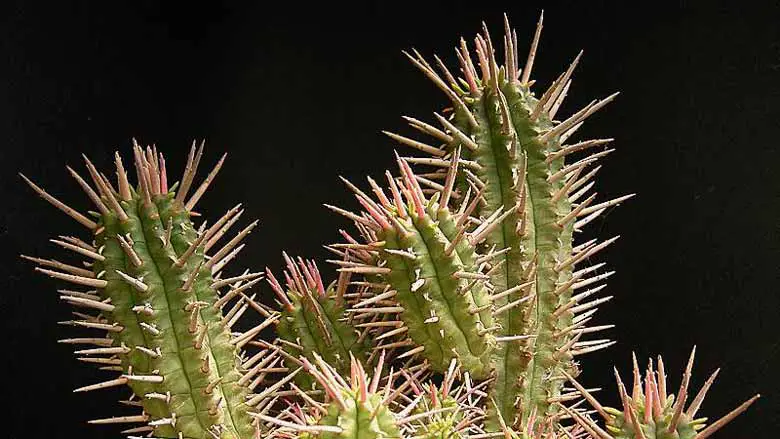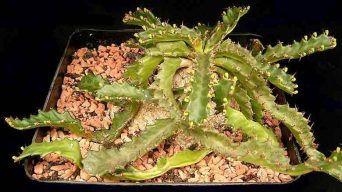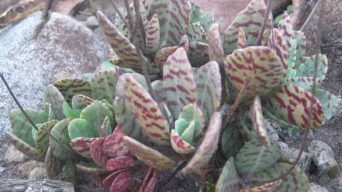The Euphorbia ferox succulent plant is a beautiful and rare type of cactus that is an excellent addition to any garden.
This plant is an easy-to-grow, drought-tolerant plant that is great for people who live in warm and dry climates.
This care guide will show you everything you need to know to take care of your Euphorbia ferox plants and how to propagate them too!
Overview
Euphorbia ferox is an ornamental, perennial flowering plant in the family Euphorbiaceae, commonly known as Spurge family, native from South Africa.
This plant is a spiny succulent shrub that branches at the base. It will form clusters up to 24 inches (60cm) in diameter.
The Euphorbia ferox succulent plant has spherical, green stems about 2 inches in diameter with small ephemeral leaves.
The spines are thick, rigid, straight, reddish that turn purple and grey. This succulent blooms a cluster of small yellow flowers.
Euphorbia ferox is commonly confused with Euphorbia enopla, but Euphorbia ferox differs by having thicker stems.
How To Care for Euphorbia Ferox
Euphorbia ferox care is a relatively easy task that can be accomplished by following some simple steps.
The following instructions are a general guideline for Euphorbia ferox care.
Sun Exposure & Light Requirements
Euphorbia ferox is best grown in full sun to partial shade.
It is important to note that this plant prefers filtered sun, and intense sunlight may burn the leaves.
The euphorbia ferox succulent can grow in partially shady areas, but it should not be exposed to too much shade.
Generally, this Euphorbia grows best with a minimum of six hours of direct light daily.
When grown indoors, it should be placed in a window with just enough sun to provide light without harsh heat. The best location for succulents is on a windowsill in an east-facing window.
When outdoors, euphorbia ferox should be planted in a location that provides protection from the afternoon sun.
The more light the euphorbia plant gets, the fuller and healthier it will grow.
If grown outdoors, euphorbias can withstand full sunlight. However, they need to be brought indoors when days get shorter or colder for winter, so they won’t grow extremely long and spindly.
Watering Requirements
The Euphorbia ferox plant is a succulent, so it requires little watering.
This Euphorbia species needs to be watered thoroughly and deeply at least once every two weeks for the soil to stay moist enough.
It is best to allow the soil to dry out slightly between watering cycles, as succulents don’t need to be watered often.
Watering this euphorbia species more often than necessary will lead to rot, killing the plant completely if not taken care of quickly enough.
Soil Requirements for Euphorbia Ferox
The Euphorbias ferox plants prefer soils that are porous and fast-draining.
The best potting soil for Euphorbias is those that contain cactus potting mix, sand, or perlite.
When planted in a pot, the Euphorbia ferox has shallow roots that grow down just a few inches into the soil.
To compensate for this and improve drainage, it is recommended that gravel or broken pieces of clay pots be mixed in with the top layer of soil below where you will plant your Euphorbias so they can draw water from these deeper layers.
This also ensures better aeration around their root zones.
If the Euphorbias ferox are planted in the ground, mixing a few inches of sand into the top layer of soil where you will plant them is recommended.
This will help with drainage and also provide some additional nutrients for your euphorbias plants.
If they are grown outdoors, they should be planted at least 12 inches deep so that rainwater can flow around their shallow roots below the surface.
Temperature and Humidity
For the Euphorbia ferox to survive and grow, it needs a temperature that is within 20°C – 30°C (68°F – 86°F) during the day.
It also needs high humidity, around 80% – 90%.
When it is too cold, the euphorbia ferox succulent will close its leaves and not open them again until they reach 20°C (68°F).
This plant may adapt in areas with low humidity levels by opening up more pores on its leaves to release moisture from within as a counterbalance for evaporative water loss.
It should be noted that these plants are susceptible to changes in environmental conditions and can become stressed or even die if they’re exposed to drastic fluctuations in temperatures or humidities without being gradually acclimated first.
Fertilizing
Fertilizing Euphorbia ferox is unnecessary, but it can be an excellent option to encourage fast and larger growth.
It is easy to do and will make a huge difference in the size of your plant. In addition, fertilizing can also help the health of your plants by providing them with important nutrients.
When fertilizing Euphorbia ferox, using a weak water-soluble fertilizer like a cactus or succulent plant food is always best.
A stronger solution of fertilizer will not only burn the Euphorbia ferox, but it will also be too much for them to handle.
To fertilize your Euphorbia ferox, apply the diluted liquid around their roots and wait until they have absorbed back into the soil before watering again.
You should only fertilize your plant during the growing season, in spring and summer.
Potting and Repotting
Depending on the size of your Euphorbia ferox, you will need to repot it every couple of years.
Over time, a Euphorbia ferox can grow too large for its pot and start showing signs of stunted growth.
If you notice that your Euphorbia ferox is growing too large, it might be time to repot.
The best way to do this is by cutting the root ball away from the edge of the pot with a sharp knife or garden shears and then gently placing your euphorbia ferox plant in a new container.
It’s also important not to water succulents right after transplanting them. They need some time without moisture so their roots can re-establish themselves in the soil before taking up any more water.
It would be best if you waited a week or two before watering your Euphorbia ferox.
If you are potting up the Euphorbia ferox for the first time, it’s best to use a container that is only slightly larger than its original one so that there isn’t too much soil exposed at the top of the pot and because they will soon need more space.
This new container must have drainage holes in the bottom since succulents don’t like their roots sitting in wet soil.
Pruning
Pruning Euphorbia ferox is best done in the early spring or fall.
When it’s dormant, prune off any dead branches that have fallen from the plant in the winter. Be careful not to cut into live wood while you’re doing this!
If a branch has died and stayed erect after its leaves fell off, remove it by cutting just past where it meets another branch on either side of its stem.
For branches growing towards each other or crossing over one another, prune them back to an outward-facing angle of at least 30 degrees from their current position.
This will help keep your Euphorbia ferox looking tidy!
Pests and Diseases
The Euphorbia ferox plant is relatively pest-free, but you may still have some issues.
Several pests like to feast on Euphorbias, including aphids and mealybugs.
- Often, the most common pest for Euphorbias are aphids. Aphids will suck on the Euphorbia, causing it to produce a sticky sap that makes them difficult to remove with water alone.
- Mealybugs are tiny insects covered in white and yellow scales (hence their name). They attach themselves to euphorbias and eat away at its leaves.
In addition to pests, there are some diseases you may come across if your plant is stressed or isn’t getting enough sunlight or water.
The most common disease for euphorbias is root rot which can be fatal without proper care after diagnosis.
Root rot starts from leaf decay caused by too much moisture around the roots of succulents like Euphorbia ferox plants due to overwatering.
How to Care for Euphorbia Ferox in Winter
Managing the winter care of Euphorbia ferox succulents is straightforward, yet it necessitates specific considerations.
- Provide bright lighting for your Euphorbia ferox succulent plant during these cold months if possible (but avoid scorching direct sunlight).
- Keep the Euphorbia ferox succulent plant on the dry side, watering only when it starts to wilt.
- Don’t fertilize Euphorbia ferox plants during this time.
- Euphorbias can be brought indoors as long as they’re given bright light and temperatures stay at 55 degrees Fahrenheit or higher during the day (with no less than 60 degrees night temperature).
- The Euphorbia ferox should not experience any temperature fluctuations.
How To Propagate Euphorbia Ferox
The Euphorbia ferox can be propagated by cuttings, offsets, and seeds.
Cuttings
To propagate Euphorbia ferox by cuttings, use the following steps:
- Choose a healthy stem with at least four shots and cut it from its mother plant.
- Remove any leaves or flowers from around the base of your selected shoot, and make sure to use sharp, clean pruning shears for this, as dull blades can damage the cutting when taken off of another plant.
- Allow cuttings to dry out for at least a day to callus over before planting.
- After the cuttings have had a chance to dry, plant them with the rooting end facing down into well-draining soil and keep their roots cool by misting or covering them with a plastic pot for up to two weeks.
- Provide plenty of light and water sparingly when the soil is dry.
- After a few weeks, cuttings will be rooted, at which point they can be transplanted outdoors or into pots.
Euphorbia ferox propagated through this method has an increased chance of survival than other methods and is often faster to root.
Offsets
To propagate Euphorbia ferox by offsets, use the following steps:
- Allow a plant to grow and divide naturally.
- When an offset has grown large enough that it is no longer connected to its mother plant, take care in detaching it from the parent plant so as not to damage any roots or shoots.
- Allow the new offset to dry out for at least a day before planting it with its roots and shoots facing down into well-draining soil.
- Water sparingly until offsets are rooted, at which point they can be transplanted outdoors or into pots.
- Offsets propagated from Euphorbia ferox have increased chances of survival and are often faster to root than other methods.
Seeds
Euphorbia ferox is also grown by direct seeding, but this method has a lower success rate due to the slow germination process for most euphorbias.
To propagate Euphorbia ferox by seeds, use the following steps:
- Choose a healthy euphorbia ferox plant to collect seeds from by looking for one in full sun and has plenty of water.
- Allow the Euphorbias’ fruit or seed pods to dry out on the stem before harvesting them.
- Fill any containers with a well-draining soil and cover the seeds with coarse sand or perlite.
- Sprinkle water over the surface of your pots to moisten them before planting Euphorbia ferox at a spacing about twice as wide as their mature size, taking care not to bury any seed beneath dirt when you do this.
- Cover your pots in plastic to increase moisture retention and keep the soil from drying out.
- Keep euphorbias watered until they are well rooted, then remove the plastic coverings so that they can continue growing steadily.
- Seeds propagated from euphorbias are less likely to grow successfully and more prone to problems.
Seeds propagated through this method have a lower rate of success than other methods, but it is still possible to grow into healthy plants if all necessary steps are followed properly.
Is the Euphorbia Ferox Toxic?
The Euphorbia ferox succulent plant is not toxic to humans but can be a skin irritant.
If you have sensitive skin or allergies, take caution because the Euphorbia plant’s milky sap contains irritating chemicals that could cause problems for your health.
Try wearing gloves and washing your hands after touching it.
If this doesn’t work for you, stop using Euphorbia plants as houseplants.
Final Thoughts
The Euphorbia ferox is a beautiful and hardy plant to keep.
It needs attention at times, but in general, it tends to grow well indoors without too much care.
If you are looking for an easy succulent that will thrive with little attention, Euphorbia ferox should be your choice!







